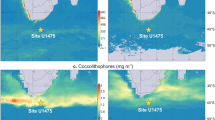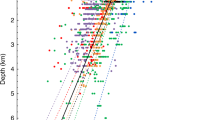Abstract
THE conditions controlling primary production are very different in the modern North Atlantic and North Pacific oceans1, a difference that is reflected in the composition of diatom fossils in surface sediments. By contrast, I report here evidence that during the last glacial interval the diatom assemblage, and by extrapolation the primary production, was very similar in the two regions. The modern analogues of these assemblages occur in sediments of Baffin Bay and the Sea of Okhotsk, both highly productive seas where ice is present. I infer that during the last glacial interval plankton biomass was at least as high as it is today in the North Atlantic, and was as much as an order of magnitude higher in the North Pacific. The glacial assemblage occurs in lithologies dominated by ice-rafted detritus, which is generally believed to indicate the presence of icebergs2–6. I hypothesize that the presence of numerous icebergs, possibly associated with sea ice, supported high production by physical mechanisms (such as turbulent mixing and enhanced density stratification) and/or biogeochemical ones (such as supply of major or trace nutrients).
This is a preview of subscription content, access via your institution
Access options
Subscribe to this journal
Receive 51 print issues and online access
$199.00 per year
only $3.90 per issue
Buy this article
- Purchase on Springer Link
- Instant access to full article PDF
Prices may be subject to local taxes which are calculated during checkout
Similar content being viewed by others
References
Parsons, T. R. & Lalli, C. M. Oceanogr. Mar. Biol. A. Rev. 26, 317–359 (1988).
Bramlette, M. N. & Bradley, W. H. U.S. Geol. Surv. Prof. Pap. 196, 1–34 (1942).
Kent, D., Opdyke, N. D. & Ewing, M. Bull. geol. Soc. Am. 82, 2741–2754 (1971).
Broecker, W., Bond, G., Klas, M., Clark, E. & McManus, J. clim. Dynam. 6, 265–273 (1992).
Bond, G. et al. Nature 360, 245–249 (1992).
Ruddiman, W. F. Bull. geol. Soc. Am. 88, 1813–1827 (1977).
Martin, J. H., Gordon, R. M., Fitzwater, S. & Broenkow, W. W. Deep-Sea Res. 36, 649–680 (1989).
Morel, F. M. M., Rueter, J. G. & Price, N. M. Oceanography 4, 56–61 (1991).
Miller, C. B. et al. Limnol. Oceanogr. 36, 1600–1615 (1991).
Feldman, G. et al. Trans. Am. Geophys. Un. 70, 634–641 (1989).
Sancetta, C. & Silvestri, S. Paleoceanography 1, 163–180 (1986).
Anderson, G. C., Lam, R. K., Booth, B. C. & Glass, J. M. NOAA Spec. Rep. 76, 477–798 (1977).
Maynard, N. G. thesis, Univ. of Miami (1974).
Keigwin, L. D., Jones, G. A. & Froelich, P. N. Earth planet Sci. Lett. (in the press).
Zahn, R., Pedersen, T. F., Bornhold, B. D. & Mix, A. C. Paleoceanography 6, 543–560 (1991).
Williams, K. M. Mar. Micropaleont. 10, 327–341 (1986).
Subba Rao, D. V. & Platt, T. Polar Biol. 3, 191–201 (1984).
Larssen, B. B., Elverhoi, A. & Aagaard, P. Polar Res. 5, 313–315 (1987).
Wollenburg, I., Pfirman, S. & Lange, M. Eos 69, 1263 (1988).
Barnes, P. W., Kempena, E. M. & Reimnitz E. Eos 69, 1263 (1988).
Horner, R. in Sea Ice Biota (ed Horner, R.) 148–157 (CRC Press, Boca Raton, 1985).
Hart, T. J. Discovery Rep. 21, 261–356 (1942).
Neshyba, S. Nature 267, 507–508 (1977).
Jacobs, S. S., Huppert, H. E., Holdsworth, G. & Drewry, D. J. J. geophys. Res. 86, 6547–6555 (1981).
Josberger, E. G. in Iceberg Utilization (ed. Husseiny, A. A.) 245–264 (Pergamon, New York 1978).
Allison, I., Knowles, K. & Wright, S. Iceberg Res. 9, 3–9 (1985).
Shulenberger, E. Polar Biol. 2, 149–158 (1983).
Jacobs, S. S., Gordon, A. L. & Amos, A. F. Nature 277, 469–471 (1979).
Appollonio S. Science 180, 491–493 (1973).
Gran, H. H. Int. Conseil Explor. Mer. Jour. 8, 343–358 (1932).
Martin, J. H., Gordon, R. M. & Fitzwalter, S. E. Nature 345, 156–158 (1990).
Morleyh, J. J. Quat. Res. 20, 374–386 (1983).
Morley, J. J., Hays, J. D. & Robertson, J. H. Deep-Sea Res. 29, 1485–1499 (1982).
Barnola, J. M., Raynaud, D., Korotkevich, T. S. & Lorius, C. Nature 329, 408–414 (1987).
Author information
Authors and Affiliations
Rights and permissions
About this article
Cite this article
Sancetta, C. Primary production in the glacial North Atlantic and North Pacific oceans. Nature 360, 249–251 (1992). https://doi.org/10.1038/360249a0
Received:
Accepted:
Issue Date:
DOI: https://doi.org/10.1038/360249a0
This article is cited by
-
Following iceberg footprints
Nature (1992)
Comments
By submitting a comment you agree to abide by our Terms and Community Guidelines. If you find something abusive or that does not comply with our terms or guidelines please flag it as inappropriate.



